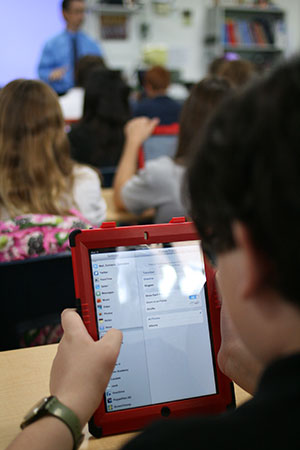
Whether they know it or not, Catholic school students at all 29 elementary and six high schools are now being held to a new learning benchmark known as the Arizona’s Common Core Standards.
While the standards apply to English and mathematics, they overlap into other subjects.
Arizona adopted the new standards in 2010 and is among 17 other states fully phasing in the norms across all grades this school year.
The standards reflect practices, content and application that align with college and work expectations.
The National Governors Association, the Council of Chief State School Officers and the nation’s secretary of education developed the standards. Content experts, teacher experience, researchers and old state standards also contributed.
In the Diocese of Phoenix, four curriculum committees representing Catholic schools revised and updated the diocesan curriculum so that it incorporates the national and state common core standards.
It’s recommended that campuses fully implement them by the next school year. Many elementary schools should see common core math standards being taught. Teachers and principals at each school put the standards into practice.
Administrators in the Diocese of Phoenix and the National Catholic Educational Association ensure the standards in no way compromise a school’s Catholic identity or educational program. The Common Core Catholic Identity Initiative has a similar mission.
While balancing new standards and developing teaching methodologies will keep Catholic school students academically competitive, the diocese’s schools maintain a primary focus on Catholic identity.
“The reason we will not simply take a set of publically approved standards and adopt them without consideration is that those standards are missing crucial components,” said MaryBeth Mueller, superintendent of Catholic schools in the Diocese of Phoenix, “This includes Catholic identity standards and the very best of our traditional curriculum standards.”
She added, “We go above and beyond the basics of common core.”
The most comprehensive guide for Catholic schools, which combines the best of common core and Catholic identity, was developed in the Catholic School Standards Project, led by Dr. Lorraine Ozar of Loyola University, Chicago.
“In the Diocese of Phoenix, we use resources such as this to ensure that our curriculum is more than simply a secular academic guide and, instead, intertwine Catholic values, concepts, and culture in all we teach and learn,” Mueller said.
It’s a more in-depth look at concepts, but still approaches learning through a Catholic lens, Sr. Melita Penchalk, assistant superintendent for the diocese and a member of the Common Core Curriculum committee, said. That won’t change with the national added common core benchmark. The standards do, however, present “a fundamental shift” in the teaching and learning process, the NCEA said in a statement on Common Core State Standards. They emphasize critical and analytical thinking alongside application of content.
Collen McCoy-Cejka, assistant superintendent, said the standards move teaching from more passive to active learning. It’s not enough to teach facts and memorization when a simple Internet search can yield the same results, she said.
Now, it’s using those facts to facilitate class discussion.
“It’s all infused with and informed by our Catholic worldview,” said David Sorkin, assistant principal for academics at Seton Catholic Preparatory High School in Chandler.
So is math. Elementary studies, for example, connect mathematical concepts with Catholic social teaching. Students find solutions for creating a peaceful, productive and more equitable world. Instead of working with abstract numbers, students learn through concrete examples.
Katie Zach, a third-grade teacher at Blessed Pope John XXIII Catholic School in Scottsdale, said the new rules naturally fit her teaching style by allowing students to think more critically. It avoids crunching numbers purely for the exercise.
She enjoys that the guidelines encourage students to talk and discuss at a younger age. Discussions teach students there can be different approaches to the same problem.
“In a Catholic school, we intertwine our faith in all we do and this is just intertwining all the subjects into one long conversation throughout our day,” Zach said of the norms.
Junior high math is approached differently too. What was traditional homework is now done in class at Blessed Pope John XXIII. The teacher is there to help. Teachers quiz students during lessons — “What do we know?” and “What do we need to find out?” — instead of dictating numerical problems.
Janet Mambrino, co-chair of the mathematics department at Xavier College Preparatory, sees the focus more on practice and problem-solving tasks. She expects it to bring a deeper understanding of the concept while developing critical thinking, collaboration and integration.
She has seen students develop such skills through Xavier’s engineering course that solely focuses on applied projects in the community. Concrete, direct answers may not be possible.
“It focuses on the students finding the problems and the solutions. The students are doing much more of the legwork,” McCoy-Cejka said.
The Common Core Standards require reading critical literary content of various genres and literary non-fiction. The idea is to prepare students to read, write and research across the curriculum.
Dr. Kathleen Conway, co-chair of Xavier’s English Department, said teachers found that much of what is now expected is already being met in class.
Dr. Karl Ochsner, a junior high science teacher who also leads technology integration at Blessed Pope John XXIII Catholic School in Scottsdale, agreed. He complimented teacher pedagogy for implementing some standards before they were coined as such.
Ochsner joined a roundtable discussion last week with the nation’s secretary of education to report on common core and teacher professional development.
He said that perhaps the biggest change is seeing technology as a need, not a privilege. The guidelines call for students to make multimedia projects.
“My green screen gets a lot of use when it comes to putting themselves in different environments for science, social studies, math and language arts,” Ochsner said. ✴





